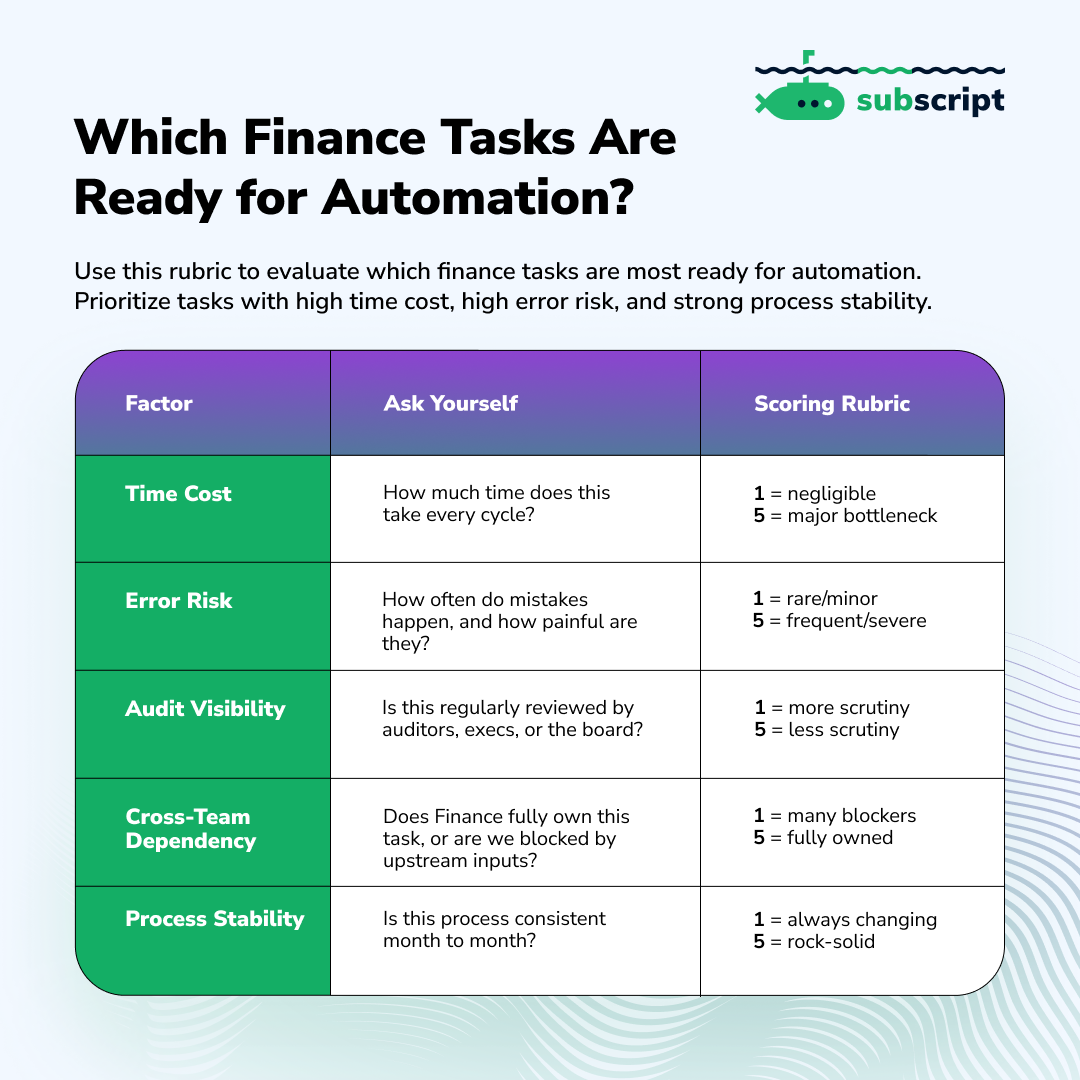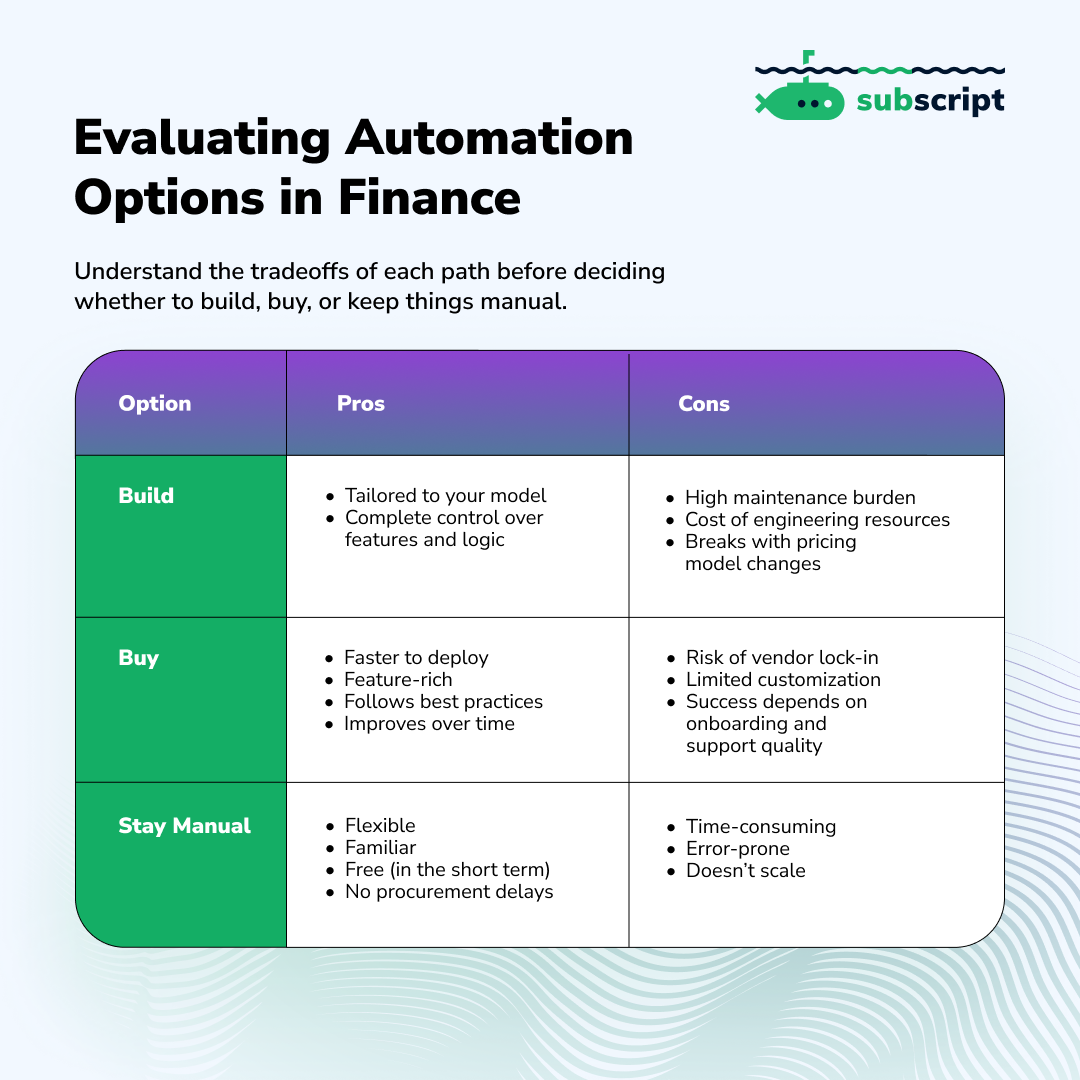If you’re running a growing business, you need to invest in your close. At some point—with more customers, more invoices, or more complexity—your lengthy and manual process will hit a wall and the inevitable question will be: Should we automate this?
But knowing you need automation is not the same as knowing where to start. Choosing the right entry point matters because a faster, cleaner close means better decisions, sooner.
Some teams dive in with unrealistic expectations. Others wait until they’re fully underwater. And many don’t realize that “automating the close” isn’t a single switch to flip. It’s a series of targeted improvements, each with its different risks, requirements, and returns.
This guide is for finance teams who have good intentions, feel the strain, know the stakes, and want a smarter way to move forward and improve their close process. We’ll help you identify the best places to start, avoid common traps, and focus on automation that actually improves speed, quality, and scale.
One Task at a Time
When finance leaders say they want to “automate the close,” they’re usually thinking too big.
The close isn’t a single checklist item. It’s an ensemble of interdependent tasks spanning accounting, FP&A, RevOps, compliance, people operations, and so many other teams. Trying to automate all of it at once will either fail outright or create more chaos.
If you want real ROI, you’ll need to zoom in:
Where’s the time going?
Pull the last three close calendars. Timebox each step. Where is your team consistently missing deadlines, and why? Which team member is always late and/or struggling?
What’s stable enough to automate?
Which workflows are consistent and repeatable, and which are still evolving or full of exceptions?
Where are the bottlenecks?
Do Legal, HR, or Sales consistently block your process? Where do handoffs arrive late or in the wrong format?
What’s over-scrutinized?
What areas are you wasting time on where the risk is limited? Are you spending time checking documents with extreme diligence though nothing’s ever wrong and/or errors are immaterial?
What breaks under pressure?
Which parts of your close get messy when volume spikes or team members are out?
💡 Your goal is to reduce manual effort where the tasks and outcomes are predictable, so your team can focus their judgement where it truly matters.
Don’t Start with the Solution
Jumping straight to automation can lead to time and resource waste. First, audit your existing workflow.
Before you talk to vendors or build anything, map your current close process in detail. Not what’s supposed to happen, but what actually happens.
Have each team member perform walkthroughs of their processes, record videos or do a live screen share of their real workflow. Watch out for spreadsheet workarounds, manual rework, inefficient handoffs, and sequencing issues.
At each friction point, ask:
- Is this a tooling issue, a process gap, or a training problem?
- What’s being done inefficiently just because “that’s how we’ve always done it?”
- What’s the actual cost (time, accuracy, rework) of leaving this task as-is?
This kind of groundwork clarifies where your team is getting stuck, and whether automation is the right fix.

Build, Buy, or Do Nothing?
If you have internal engineering resources, building might seem appealing. But be careful: custom tooling without ongoing support is risky. One pricing model change can make your in-house billing or rev rec solution obsolete. You’ll need a plan for how your accounting engineering will be maintained. Will you have a team available to test and document everything?
Buying gets you speed and maturity, but it comes with its own challenges. You’ll likely require implementation support, and with the wrong partner, you may not have real input into the company’s feature roadmap. Make sure you have reasonable expectations.
Before you commit to any option, run a side-by-side comparison with your manual process. Be sure to consider edge cases and future scale. What could break if your billing model changes? Or if you add new entities? Or double contract volume? How responsive is the customer support at this vendor? Can they scale?
In some cases, you may not need automation at all. A better process, employee, or updated template might save more time than a new tool.
Here are a few baseline considerations:

Can I Just Use ChatGPT or Other AI Tools?
If you’re not ready or able to adopt a new tool today, that doesn’t mean you have to give up on improving your workflows. With practice, LLMs can help streamline your workflows.
Here are a few use cases to explore:
- Classifying transactions based on past patterns
- Drafting variance explanations for monthly reports
- Flagging revenue anomalies for review
- Accelerating documentation for auditors and leadership
🚧 Use good judgement: Don’t expose PII or sensitive data to the free version of an LLM and always keep a human in the loop.
This approach builds automation muscle, without needing a full implementation.
Where to Start: 3 Areas With High ROI and Low Risk
Every company’s pain points are different. But some automation wins are common across the board.
If you’re looking for a quick but strategic first step, start here:
Reconciliations
Bank, prepaid, and fixed asset reconciliations follow consistent logic. If you’ve been using the same Excel tab for more than six months, it’s probably automatable. You can practice by automating these simple reconciliations first.
Revenue Journal Entries
This is where manual pain adds up fast, especially if your contracts, billing systems, and GL aren’t connected. Auto-generated journal entries can unlock major efficiency.
Exception-Based Reviews
If your team is still manually reviewing every payroll run or purchase order, you’re spending time where you don’t need to. Use automation to flag only the outliers.
None of these are silver bullets. But they’re low-risk upgrades that give your team more breathing room and help you build momentum for broader improvements.
What to Remember
When it comes to automation, you don’t need a perfect plan. But you do need clear priorities and a focused approach to making it happen.
Keep these principles in mind:
- Don’t let tools outrun process. If you don’t know what’s broken, software won’t fix it. It could be a people problem.
- Only automate tasks that are stable and well understood. If your process is in flux or still being figured out, it may be too early to automate.
- Don’t try to automate everything at once. Pick one high-leverage task, get it right, and build from there.
- Validate everything before going live. One automated error can be more dangerous than ten manual ones.
- Expect a slow down before the close speeds up. Results won’t be instant, even with a great tool. Give your team time to learn, test, document, and debug.
Automation works best when it’s focused, deliberate, and grounded in your team’s real bottlenecks. Solve the right problems, and you’ll close faster, with fewer errors, cleaner data, and more strategic headroom.
Ready to Speed Up Your Month-End Close?
Subscript automates billing, rev rec, and reporting across even the most complex SaaS models—so finance can move faster, with more confidence.
🔎 Want to see how it works? Schedule a demo.
%20(2).svg)

.svg)
.svg)




.svg)





.svg)


.svg)







